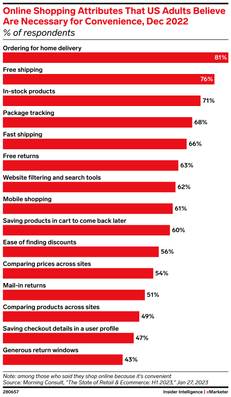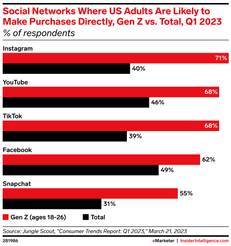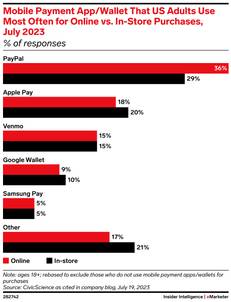Since smartphones are a nearly inescapable part of consumers’ daily lives, consumers have come to rely on these devices for browsing and buying things.
Over 60% of US adults believe that mobile shopping is a necessity for convenience in online shopping, according to a December 2022 Morning Consult poll.
The trend means retailers and online marketplaces must create well-designed, easy-to-use experiences for both their mobile websites and apps. Per EMARKETER’s June 2024 forecast, on average, US mobile phone users will spend just 3 hours and 15 minutes (3:15) per day on their phones in 2024.
As smartphone use increases, so too do mcommerce sales. In 2024, US retail mcommerce sales will reach $542.73 billion, and account for 7.4% of total retail sales, according to a February 2024 EMARKETER forecast. Further, mcommerce is estimated to make up 44.6% of total US retail ecommerce sales in 2024.
In this guide, we break down the different mcommerce trends that retail and commerce marketers should be aware of to reach their target audiences.
- Want to learn more about mcommerce and other retail trends? Sign up for the Retail Daily newsletter.
Mcommerce vs ecommerce
Ecommerce refers to the buying and selling of goods and services over the internet across various devices, including desktops, laptops, and tablets. Ecommerce websites typically offer detailed product listings, multiple payment options, and comprehensive customer service, often integrating both online and offline fulfillment options
Mcommerce is a subset of ecommerce that focuses specifically on transactions conducted via mobile devices such as smartphones and tablets. Mcommerce is characterized by its mobile-optimized user experience, streamlined interfaces, and features like mobile payments, push notifications, and location-based services.
While mcommerce is a component of ecommerce, its focus on mobile devices gives it distinct characteristics and a growing importance in the digital commerce landscape.
Shoppable media and social commerce
Smartphones and social media usage go hand in hand as Instagram, TikTok, and other platforms are predominantly app-based. US mobile phone users will spend an average of 1:15 per day on social networks, according to EMARKTER’s February 2024 forecast.
Due to social media’s role as a discovery point for new products (from brand accounts, influencer content, or sponsored ads), adding shopping capabilities just made sense for social platforms. Shoppable media can enable seamless purchases through branded content or ads—as videos or static images—that go straight to a product page or feature a link to buy directly within the app or retail site.
Shoppable media makes social commerce—which is giving US mcommerce a boost—easier and more streamlined, taking the consumer from consideration to purchase in just a few clicks.
To encourage shoppers to make purchases in-app, some social platforms have introduced native checkout tools. Instagram Checkout, for example, allows users to save their payment details to the app. When ready to make a purchase, Instagram autofills the user’s information to complete a transaction. However, users have been reluctant to complete purchases in-app.
Because of this consumer hesitation, Pinterest has taken a different approach to social commerce through its partnership with Amazon. From a Pinterest shoppable ad, the user is taken to the featured product’s Amazon listing for purchase. Research shows that nearly three-quarters of consumers ages 16 to 24 prefer to buy directly from retailers, according to an October 2022 SimplicityDX survey. Data privacy is a concern, but consumers would rather have an established retailer handle transactions, shipping, and delivery.
The introduction of TikTok Shop in 2023, however, underscores the potential of social commerce. Despite having fewer US social buyers than Meta’s Facebook and Instagram, nearly 70% of Gen Z is willing to purchase goods directly on TikTok, according to Jungle Scout.
On TikTok, influencers play a key role in social commerce’s momentum. TikTok Shop listings and affiliate links, for instance, provide TikTok with an opportunity to tap into influencer marketing by being part of those transactions.
Influencers are a point of discovery in their own right and encourage followers to purchase goods featured on their accounts. In 2022, 50.2% of US internet users purchased a product after seeing it used by an influencer, according to Izea’s 2023 Trust in Influencer Marketing study.
Even with consumers putting trust in influencer product recommendations, influencer-led live shopping events, streamed on apps like TikTok, Instagram, and Twitch, haven’t taken off in the US like they have in China.
Less than a quarter (23%) of US livestream viewers buy products during live shopping shows, per a December 2022 Coresight Research survey. Slightly more viewers buy products recommended by the host (29%) or buy the featured products post-livestream (34%).
Connected TV’s commerce potential
In addition to spending time on mobile devices for commerce and other activities, consumers are also watching more connected TV (CTV). In 2024, US viewers will spend a little over 2 hours every day watching CTV content.
With an increase in CTV viewership, ad spending by brands and retailers has followed, opening the door for CTV ad formats that can lead to mcommerce opportunities. In 2024, EMARKETER forecasts CTV ad spending will exceed $28.75 billion.
By comparison, in 2019, when the forecast first began, viewers spent under an hour (0:57) with CTV and ad spending was just shy of $7 billion.
Retail media partnerships, for example, have driven shoppable CTV as brands look for ways to narrow the gap between awareness and purchase.
QR code use has soared as marketers look to create a more interactive and trackable experience. In 2024, 97.8 million US consumers will use smartphone QR scanners, and that number will be 102.5 million 2025, per EMARKETER’s February 2024 forecast.
Though not exclusive to CTV or linear TV, QR codes can be used to access additional information and are often used to bring users to a purchase moment.
In-store mobile usage and commerce
Smartphones are the nerve center of omnichannel shopping experiences as more consumers use their mobile phones while shopping in-store.
Nearly 80% of consumers worldwide visit a retailer’s website from their smartphone while shopping in-store, while 74% use a retailer’s app, according to a March 2023 study by Airship and Sapio Research. While in-store, consumers are likely to use their phones to compare prices, read reviews, access digital loyalty cards and coupons, and more.
Increasingly, shoppers expect smartphone-like capabilities to be integrated into the physical store. 50% of consumers take into account how easy it is to check out on a retailer’s ecommerce site or app when deciding where to shop online, per a PYMNTS consumer survey.
Retailers should prioritize smartphone optimization and in-store mobile integration. Features such as “scan and go,” QR codes, and AR have the potential to deliver seamless and engaging omnichannel experiences.
To meet consumers’ expectations, in-store digitization is bringing the best aspects of online shopping into the physical retail space. It will ultimately reshape how consumers discover, engage with, and purchase goods.
For example, some retailers are experimenting with mobile integrations like digital wayfinding through location tracking, which helps locate the right aisle and shelf of a product, and digital merchandising, which offers ratings and reviews on the shelf. These mobile-enabled add-ons will boost in-store engagement while also influencing product consideration, and, ultimately, purchases.
In-app mobile commerce
Mobile apps are popular among consumers and have seen adoption continue to rise since the COVID-19 pandemic, when app usage saw a noticeable surge. In 2022, consumers worldwide spent more time on mcommerce apps (12%) compared with 2021, per a March 2023 report by Adjust.
But not just any mcommerce app will do—consumers are drawn to apps that add value to the shopping experience. Features such as loyalty programs (63.4%) and exclusive offers (62.5%) are considered the most valuable to US consumers, according to an April 2023 study by Scanbot.
Likewise, incorporating user-friendly app features such as real-time inventory updates, click-and-collect capabilities, and detailed product information adds value for omnichannel shoppers.
Buy now, pay later (BNPL) payment options are also gaining traction among mobile shoppers. BNPL services, like Klarna, Afterpay, and others, are popular due to the flexibility of repayment terms, app-based shopping, and a simple user experience.
Mobile proximity payments
Mobile proximity payments enabled by digital wallets like Apple Pay or Google Pay can streamline purchases while increasing basket size and the number of shopping occasions.
The proximity mobile payment space is maturing as the technology goes more mainstream. Consumer comfort with making a purchase via their smartphone is also rising.
US adults are evenly split on using mobile payment apps online versus in-store—except with PayPal. Over one-third (36%) of users use PayPal online, compared with 29% of users who use the app in-store, according to July 2023 CivicScience data.
As the space continues to mature, mobile wallet providers will compete for users’ loyalty. Some 30% of customers intend to use three or more digital wallets in the coming years, according to McKinsey & Company research. To increase loyalty, providers will need to incorporate various functions, such as BNPL options, loyalty reward cards, and event ticketing, to avoid users needing to hop from one wallet to another to meet their needs.
By generation, Gen Zers are more inclined to pay using their smartphones. As this mobile-first generation grows into its financial prime, Gen Z will continue to drive emerging payment growth. Close to 20 million Gen Zers will adopt proximity mobile payments over the next few years, reaching 46.2 million in 2027, per EMARKETER’s forecast. Anticipating Gen Z’s expectations and shopping behaviors will be essential for retailers looking to win their long-term loyalty.
By understanding payment behaviors, retailers will be better equipped to identify what payment options they should accept at digital and physical points of sale. For example, merchants have increased their acceptance of BNPL payment methods online and in-store as more consumers prefer to pay this way. BNPL spending is expected to reach $108.43 billion by 2025, according to EMARKETER’s August 2024 forecast.
Benefits of mcommerce for retailers, advertisers, and consumers
- Collect data about shoppers’ behaviors and preferences
- Better control over the customer experience
- Greater engagement and communication with consumers
- Track consumers’ locations to determine purchasing patterns
- Reach a wider audience
- Improve product discovery
- Appeal to on-the-go consumers (purchases can be made in just a few clicks)
This article has been updated. Original was posted January 24, 2024.




